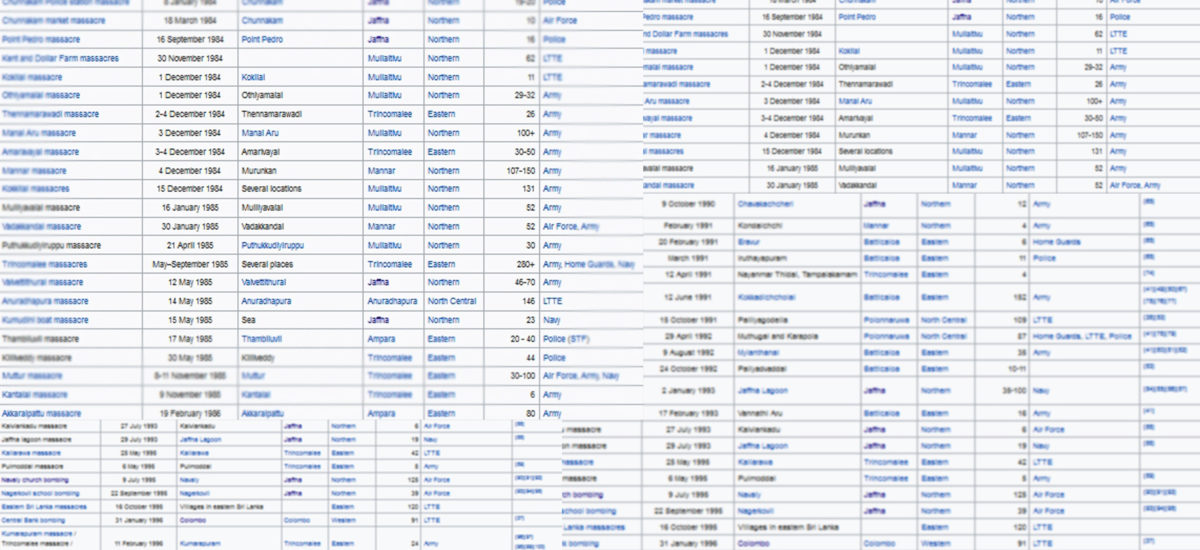Featured image courtesy Wikipedia
In 70 short years, we’ve amassed a catalogue that is overwhelming.
Limit it to just physical horror – the massacres, the burnings, the shellings – the ones whose logic placed them outside the rules of just war (as if those rules made sense in the first place) – and it is still a catalogue that stretches on and on. Each entry has a location, a date, a perpetrator and a body count. The entries form a list long enough to blur from scrolling down. Cities, towns, villages. Temples, churches, mosques. Hospitals, bus stops, libraries. Everywhere.
Nothing about this catalogue is definite.
What is online is different to what is broadcast – shaky sequences of the aftermath, and on rare occasion, grainy shots of the during. What is printed is different still – on books and reams of newspaper. And scribblings on exercise books and blackboards which will never see the light of day.
Language disrupts it. What is in Sinhala is not the same in Tamil. There are different words for killing and death with incompatible meanings. English can hardly bridge the chasm; a blunt tool often unable to visualise or articulate horror.
And of course, ethnicity colours it. How can it not? Decades of independence and centuries of dependence spent defining and self-defining, always against another – who we are because of who we are not – means that some horrors are less horrifying, or aren’t horrors at all.
The body counts don’t capture those who died too late, from injury or shock or grief. Deaths too inconvenient to be included as statistics. And how to represent wounds, or trauma? What columns could possibly capture those?
So the catalogue is actually multiple catalogues. They vary depending on who you are and what you speak and how it’s recorded and how it is interpreted. They align sometimes, of course. There are the horrors everyone knows, the ones too big to ignore. The dark months. The library on fire. The blood-swept beach. A highlight- reel of our Independence. But even here, agreement may only be on dates. Everything else, from the body counts to who inflicted the horrors to who suffered them to what, plainly, to call them, is still mutable. A hundred variable numbers, names and places.
This is not even to suggest that there is some sort of parity between these catalogues. We all know which catalogue passes for truth in this country; the one with no consequences attached for being spoken, cited and mourned.
But outside the terrible highlights, outside the stories that are factual enough to be written or uttered, in whatever language and on whatever medium to spark off a myriad interpretations of those facts themselves, outside of all of that are the horrors that remain unspoken.
Those whose witnesses have fled; those whose witnesses have perished, too; those whose witnesses are, still, holding their tongues; those, simply with no witnesses. So the catalogue is imprinted inside minds across the island, whispered if dared. It is scattered across the globe, spoken, perhaps loudly, across carpeted rooms. It is under gravestones, and simply, in the earth.
We’d like to think the catalogue, in all its forms, won’t stop growing. The fighting has stopped, after all. But time will throw up the memories. They did repeatedly over these 70 years, after all. And what cannot be spoken within these seabound confines will be spoken, and made true, elsewhere. Then, when that is not enough (and it will not be), the fighting will resume, in a different form with different players but still producing location, date, perpetrator, body count. More inches to a catalogue with no end.
So we repeat the fictions of independence and liberation and will the time to pass faster so the catalogue holds no weight, that it becomes just another, dispassionate list. A desperate kind of hoping that time will be enough to forget. We keep saying how beautiful this place is, as if repeating it will make it true. As if it will wash away the taint of the horror from the actually beautiful beaches and fields and mountains which hold the last breath of thousands. As if it will bury what we all know – that this is a violent, ugly place.
So the catalogue will never be reconciled. Its versions are too many, its weight too much, its holders too scattered. And it will never be completed, try as we might.
Editor’s Note: Click here for more content around Sri Lanka’s 70th Independence Day. Click here for our video series.

